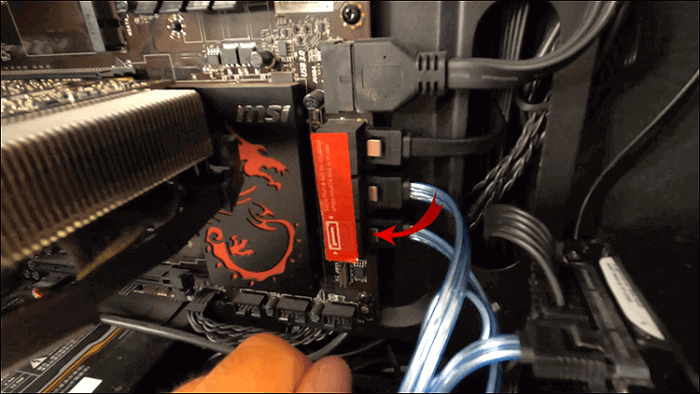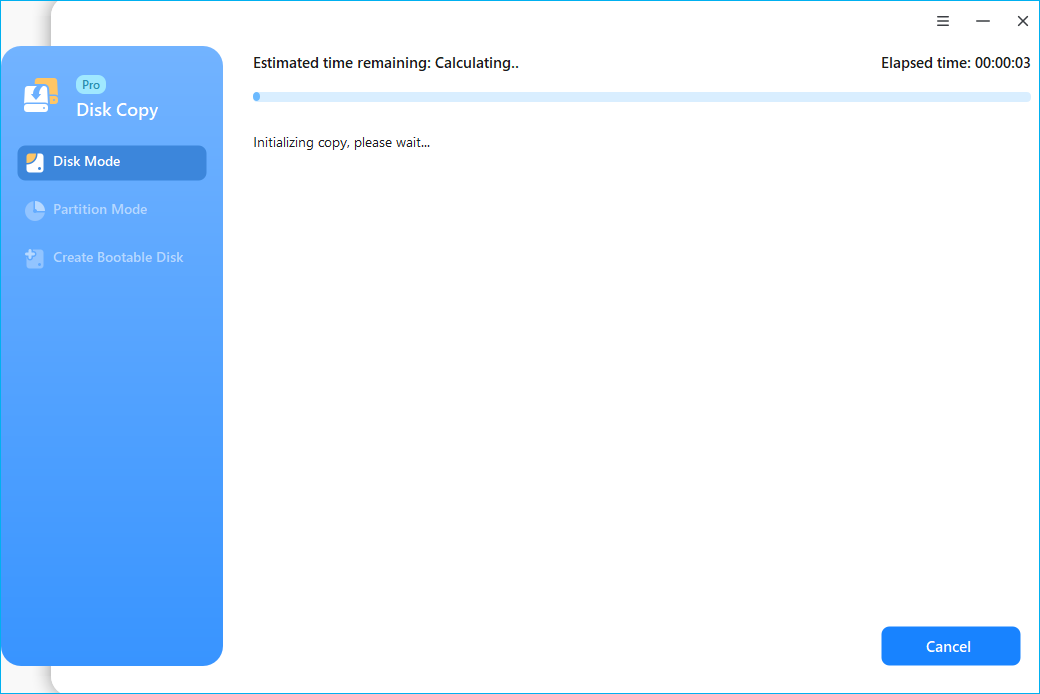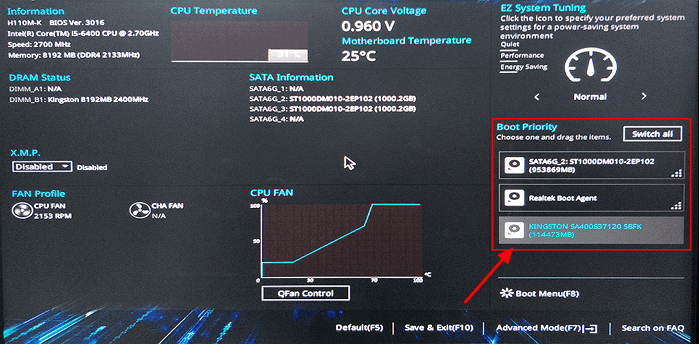Start Your Free Trial!
Sign up to our newsletter, stay updated on news and exclusive offers from EaseUS. Don't worry, if you change your mind, you can unsubscribe at any time, free of charge. We value your privacy (Privacy Policy).
Page Table of Contents
An Overview of the Primary Drive
How to Install SSD as the Primary Drive
Final Words
Install SSD as Primary Drive FAQs
Key Takeaways: How to install SSD as the primary drive
This EaseUS blog will outline an ultimate guide on how to install SSD as the primary drive with step-by-step guides, including installing SSD into the computer, transferring OS to SSD, and seting SSD as the primary in Windows.
The primary drive, also called the boot drive, is the drive in the computer for storing and accessing the operating system, software applications, and user data. It is typically an HDD or SSD that provides the main storage for the computer. The primary drive plays a crucial role in the overall performance and efficiency of the system, as it determines how quickly data can be read and written.
So, it is important to choose a reliable and high-capacity primary drive to ensure smooth and efficient operation of the computer. SSD outperforms traditional HDD in many aspects, including faster read and write speed, longer service life, more durable exterior design, more flexible usage, etc.
This is why many users prefer to install a new SSD as the primary drive instead of using the old hard drive. But they may wonder: How do I change my main drive to SSD? Don't worry; keep reading, and follow the steps below to install a new SSD as the primary boot drive. We'll also show you how to set the old hard drive as the secondary storage drive.

Installing SSD as the primary drive is a wise decision to upgrade your computer performance, improve speed, and get a better user experience. However, the process of installing SSD as the primary drive is not as simple as just adding a new disk. It involves three main steps: install SSD to your computer, migrate OS to the new drive, set SSD as the boot drive, and boot from it.
For those who have little computer knowledge, any mistake during the process will result in serious problems such as computer failure to start up or data loss. To avoid these mistakes, please ensure to follow the steps carefully.
First of all, you need to prepare an SSD that is compatible with your computer and pay attention to the SSD's format, interface, type, size, etc. In addition, ensure the SSD has enough storage capacity to accommodate all data saved on the old hard drive.
Then, install the SSD into the PC. Here, we can divide it into two cases:

Share the post on social media to help others install SSD as the primary drive effectively.
It is a waste of time if you reinstall the Windows operating system from scratch when you have a new SSD on your computer. To save time and effort, migrating OS to the new SSD is the easiest way to help you do it without any data loss.
EaseUS Disk Copy is a reliable OS migration tool to assist you in cloning the operating system from the old hard drive to SSD without any boot issue; It will automatically select all system-related files and boot sectors on any partition of your old hard drive and create a 1-to-1 copy of your Windows OS. Besides, you can adjust the SSD layout while cloning based on your preference. Its sector-by-sector clone feature lets you selectively copy the data to the target disk. If the target SSD doesn't have enough storage, the software will notify you to avoid data loss. What are you waiting for? Download it now and move OS to SSD with the guide.
📚Step instruction to migrate Windows OS to SSD:
📖Preparations before cloning start:
Step 1. Launch EaseUS Disk Copy, and connect the new second HDD/SSD to the PC. A new window will ask, "A new drive on this computer was found, do you want to migrate OS to the new drive?". Click the Yes button, and it will automatically select all system-related partitions and files.

Step 2. Adjust the target disk layout to fit into the new disk. Tick the "Check the option if the target is SSD" option to put your SSD in its best performance.

Step 3. Click the Proceed button, and a message will appear to warn you that data will be lost. Please confirm this message by clicking Continue.

Step 4. Wait for the process to complete, and you can check the integrity of the cloned hard drive and view if the OS has been migrated to it.

After cloning, you can now set the SSD with the cloned OS as the primary drive and boot your computer from it. Follow the steps below:
❤️Note: if your PC has only one slot for disk, you need to:
Step 1. Restart PC and press F2/F12/Del keys to enter BIOS.
Step 2. Go to the boot option, change the boot order, setting OS to boot from the new SSD.

Step 3. Save the changes, exit BIOS, and restart the PC, and wait patiently to let the computer boot up. After this, you can use the new SSD as your OS disk.
It is often the case that HDD comes with larger storage capacities and lower prices, so many users prefer to keep and use the original hard drive as the secondary storage drive. How to do that? You can format the old hard drive with the following steps and save music, files, videos, personal information, and applications on this drive.
Share the post on social media to help others install SSD as the primary drive effectively.
Installing an SSD as the primary drive can greatly improve system performance. By following the steps outlined in this guide, you can successfully set up your SSD for optimal use. For a seamless migration of your operating system and data to the new SSD, we recommend using EaseUS Disk Copy, a reliable and user-friendly tool that simplifies the process and ensures a smooth transition.
1. Should I use a SSD as my primary drive?
Yes, using an SSD as your primary drive is highly recommended. SSDs offer significantly faster read and write speeds compared to traditional hard disk drives, resulting in quicker boot times, faster application loading, and overall improved system performance. Additionally, SSDs have no moving parts, making them more reliable and durable than HDDs.
2. How do I format my SSD for main drive?
To format your SSD as the main drive, you can use the built-in Disk Management tool in Windows. Simply locate the SSD in the Disk Management utility, right-click on it, and select the option to format. Choose the file system (NTFS for Windows) and follow the on-screen instructions to complete the formatting process.
3. Why isn't my SSD showing up in Disk Management?
If your SSD is not showing up in disk Management, it could be due to a few reasons:
Try checking the connections, updating drivers, or testing the SSD on another computer to troubleshoot the issue.
Was this page helpful? Your support is truly important to us!

EaseUS Disk Copy
EaseUS Disk Copy is a well designed and very easy-to-use HDD/SSD cloning and migration tool, a tool which should be ideal for anyone wanting to quickly and easily migrate an existing system disk to a new disk (or newly installed SSD drive) with the minimal of configuration required.
Updated by
Written by
EaseUS Disk Copy

Dedicated cloning tool to meet all your system, disk, and partition clone needs.
Popular Posts





Interesting Topics
CHOOSE YOUR REGION
Start Your Free Trial!
Sign up to our newsletter, stay updated on news and exclusive offers from EaseUS. Don't worry, if you change your mind, you can unsubscribe at any time, free of charge. We value your privacy (Privacy Policy).
Start Your Free Trial!
Sign up to our newsletter, stay updated on news and exclusive offers from EaseUS. Don't worry, if you change your mind, you can unsubscribe at any time, free of charge. We value your privacy (Privacy Policy).